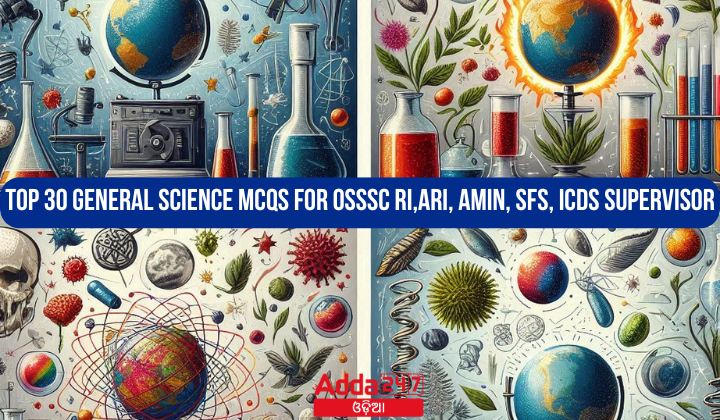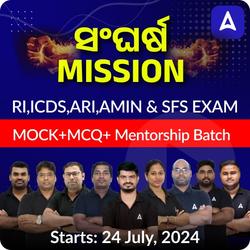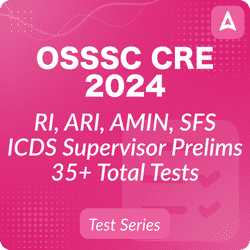General Science forms an essential part of many competitive exams in India, including those conducted by the Odisha Sub-ordinate Staff Selection Commission (OSSS(c) for various positions like Revenue Inspector (RI), Assistant Revenue Inspector (ARI), Amin, SFS, and ICDS Supervisor. To excel in these exams, candidates must have a strong grasp of fundamental scientific concepts. Here, we present the top 30 General Science multiple-choice questions (MCQs) to help candidates prepare effectively.
Top 30 General Science MCQS For OSSSC RI,ARI, Amin, SFS, ICDS Supervisor
- Which scientist discovered the element Radium?
(a) André-Louis Debierne
(b) Kasimir Fajans
(c) Oswald Helmuth Göhring
(d) Marie Sklodowska-Curie and Pierre Curie
Ans. (d) Marie Sklodowska-Curie and Pierre Curie - What is the primary protein involved in muscle contraction?
(a) Myoglobin
(b) Myosin
(c) Mucin
(d) None of the above
Ans. (b) Myosin - Lepidopterology is the scientific study of which group of organisms?
(a) Ferns
(b) Animals in stagnant waters
(c) Lipids and fats
(d) Moths and butterflies
Ans. (d) Moths and butterflies - Which test is commonly used to diagnose color blindness?
(a) Widal Test
(b) ELISA test
(c) Rorschach test
(d) Ishihara Test
Ans. (d) Ishihara Test - Penicillin, used as an antibiotic, is obtained from which source?
(a) Bacteria
(b) Fungi
(c) Algae
(d) Lichens
Ans. (b) Fungi - What type of strain is produced if a deforming force changes the shape of a body without altering its volume?
(a) Linear
(b) Volumetric
(c) Shearing
(d) All of the above
Ans. (c) Shearing - In a sound wave, what is the time taken for two consecutive compressions or rarefactions to cross a fixed point?
(a) Amplitude
(b) Time period
(c) Angular Frequency
(d) Angular Displacement
Ans. (b) Time period - According to Ohm’s law, if the resistance of a conductor is doubled, what happens to the current?
(a) It gets doubled
(b) It gets halved
(c) It increases fourfold
(d) No change
Ans. (b) It gets halved - What are the constituents of the alloy known as German Silver?
(a) Gold, Aluminium, and Copper
(b) Zinc, Iron, and Silver
(c) Bismuth, Antimony, and Tin
(d) Copper, Nickel, and Zinc
Ans. (d) Copper, Nickel, and Zinc - What is emitted during the beta-decay process?
(a) Electron
(b) Positron
(c) Both a and b
(d) None
Ans. (c) Both a and b - Which of the following factors does not influence the gravitational force between two objects?
(a) Gravitational constant
(b) Distance between the objects
(c) Product of the masses of the objects
(d) Sum of the masses of the objects
Ans. (d) Sum of the masses of the objects - What is the Gaussian unit of kinematic viscosity?
(a) Henry
(b) Stokes
(c) Poiseuille
(d) Watt
Ans. (b) Stokes - What is the correct relationship for the unit curie (Ci)?
(a) 1 Ci = 3.7 × 10^7
(b) 1 Ci = 2.7 × 10^9
(c) 1 Ci = 2.7 × 10^7
(d) 1 Ci = 3.7 × 10^10
Ans. (d) 1 Ci = 3.7 × 10^10 - Which type of rays have the highest ionizing power?
(a) Alpha
(b) Beta
(c) Gamma
(d) All have the same
Ans. (a) Alpha - What is the purpose of a rectifier?
(a) Converting alternating current into direct current
(b) Converting direct current into alternating current
(c) Increasing the power of a signal
(d) Decreasing the voltage
Ans. (a) Converting alternating current into direct current - What are compounds formed by carbon atoms linked by single bonds called?
(a) Saturated compounds
(b) Unsaturated compounds
(c) Monovalent compounds
(d) Ionic compounds
Ans. (a) Saturated compounds - Which polymers are used to produce Butyl rubber?
(a) Butadiene and neoprene
(b) Butadiene and styrene
(c) Butadiene and acrylonitrile
(d) Butadiene and isobutylene
Ans. (d) Butadiene and isobutylene - Which is the most abundant metal in the Earth’s crust?
(a) Iron
(b) Aluminium
(c) Copper
(d) Silicon
Ans. (b) Aluminium - Which type of salts are detergents commonly made up of?
(a) Ammonium and sulphonate
(b) Calcium and magnesium
(c) Cobalt and nitrate
(d) None of the above
Ans. (a) Ammonium and sulphonate - What is the correct order of iron content in these minerals?
(a) Magnetite > Haematite > Siderite > Limonite
(b) Haematite > Magnetite > Siderite > Limonite
(c) Haematite > Magnetite > Limonite > Siderite
(d) Magnetite > Haematite > Limonite > Siderite
Ans. (d) Magnetite > Haematite > Limonite > Siderite - Which of the following molecules have electrovalent bonding?
(a) NaCl
(b) MgO
(c) NH3
(d) Both a and b
Ans. (d) Both a and b - Which non-metal is liquid at room temperature?
(a) Helium
(b) Argon
(c) Bromine
(d) Sulphur
Ans. (c) Bromine - Which among the following is the hardest metal?
(a) Platinum
(b) Gold
(c) Iron
(d) Tungsten
Ans. (d) Tungsten - Who is considered the father of DNA fingerprinting?
(a) James Watson
(b) Hargobind Khurana
(c) Alec Jeffreys
(d) Nirenberg
Ans. (c) Alec Jeffreys - Which cell organelle contains RNA?
(a) Plastids
(b) Mitochondria
(c) Ribosomes
(d) Lysosomes
Ans. (c) Ribosomes - What sugar is found in RNA?
(a) Hexose
(b) Ribose
(c) Fructose
(d) Glucose
Ans. (b) Ribose - What factors can affect proteins and nucleic acids but not viruses?
(a) Denaturation
(b) Enzyme treatment
(c) Pressure
(d) All of these
Ans. (d) All of these - In which type of bacteria are fimbriae found?
(a) Gram-positive bacteria
(b) Gram-negative bacteria
(c) Both a and b
(d) None of these
Ans. (b) Gram-negative bacteria - What term describes the phenomenon where larval characteristics remain after sexual maturity?
(a) Phylogenesis
(b) Neoteny
(c) Parthenogenesis
(d) Ontogenesis
Ans. (b) Neoteny - Which state has not implemented the Right to Education (RTE) Act, 2009 as of August 7, 2024?
(a) Punjab
(b) Kerala
(c) Telangana
(d) All of the above
Ans. (d) All of the above










